Parallel Worlds: A study of Astroturfing and Polarization in modern media #
1.Abstract #
The evolution of political discourse in the digital age has fundamentally transformed how truth is constructed and maintained in society. While truth has always been shaped by intersubjective agreement, the internet’s democratization of voice has created new vulnerabilities in this social process. Recent years have witnessed a marked shift from data-driven policy discussions and formal political speech towards raw, antagonistic communication styles, exemplified by the contrast between leaders like Obama and Trump. This transformation coincides with the emergence of “Parallel Worlds” — isolated information bubbles that make the manipulating the population easier.
The internet’s unique property of allowing universal participation, while inherently democratic, has become a double-edged sword. Modern astroturf operations exploit this openness, creating artificial grassroots movements that drive polarization and effectively separate supporters and opponents into distinct reality spheres. These operations are characterized by systematic demonization of opposition, deification of one’s side, and discreditation of neutral experts. The threat is particularly acute given the absence of traditional media filters between politicians and their supporters, as demonstrated during recent election cycles where even data-rich topics like the economy were reduced to polarizing slogans despite their stated importance to voters.
Through quantitative analysis based on qualitative theory, particularly sentiment analysis, we aim to develop a framework for understanding and detecting astroturf operations, their impact on polarization, and their broader implications for democratic societies. This approach is informed by recent investigations, including the Mueller indictment [1] and Tenet media cases [2], seeking to illuminate the elusive dynamics of modern political manipulation.
2.Introduction #
Donald Trump won a second term in the White House, with economic concerns being a primary factor in voter turnout. His campaign strategy echoed Ronald Reagan’s historical slogan, ‘Are you better off?’, when he left office with record-high unemployment and a crashing economy barreling towards a global financial crisis. The following 4 years from the Biden administration have instead been nothing short of a miraculous recovery for the American economy, with the US outperforming every other country under every measurable metric, from inflation to unemployment, to investment into future periods. Yet the question: “are you better off?” was met with a resounding “no” on November 5th. There’s a clear disconnect between reality and its perception, that was simply not present in the past. We argue that it only became sustainable with the advent of the Internet and its ability to form social bubbles, where an idea can instill itself as socially hegemonous, without the constraint of geographic proximity that it had in the past. In the US, it’s possible to hear pundits say that “going to the gym has somehow become a right-wing thing”. This reflects on the historically common politicization of every-day aspects of life, which is however getting to combined to the very human tendency to form more in-group than out-group ties, and the unparalleled level of choice in relationships and sources of information offered by the advent of the Internet and, especially, social media. We argue that this combination has lead to a level of division within society on a day-to-day level that allows people to have totally different views of facts, where before they could only differ in interpretation and opinion on said facts. It’s possible for a voter to believe that fluoride shouldn’t be used in public water systems, because all it takes is for it to become the culturally hegemonic point of view in its media environment. This can happen through pure media manipulation, thanks to the lack of filter between politicians, citizens and campaigns such as astroturf operations.
Political struggle and its dynamics are key topics in disciplines such as sociology, political science and international relations, each with it unique takes on the topic, but all share the interest in power relationships and how they are obtained and justified by the ruling ones, no matter if control was achieved lawfully or, often, with the aid of un’competitive tactics, usually involving public opinion manipulation [3].
In the last years social media usage has skyrocketed which, as part of the “dataification and audit culture” [4], created exponentially more data trails and information on the web available to use, paving the way for more advanced methods of manipulating public opinion, both in and outside the political sphere, have arisen due to the innovations and reach that social media platforms boast.
Historically, the preferred outcome of manipulation has always been polarization, giving rise to strong leaders and divides [3]. Polarization is defined by Baldasarri and Bearman as “a state in which the opinions, beliefs, or interests of a group or society no longer range along a continuum but become concentrated at opposing extremes” [5]. It’s a key factor to view polarization as an outcome rather than a means, since it’s always been the objective of different political parties to achieve their goals. Now, in this era of limitless communication one would see complete polarization as harder to achieve, due to the sheer amount of different opinions available on social media, but, as anticipated, there’s a new, and arguably worse, means of achieving a polarized society: astroturfing.
Astroturfings are defined by Walker as “illegitimate political practices that involve mobilizing mass participation on behalf of a (usually) covert or undisclosed external patron” [6]. Such a practice is deeply deceptive and thrives on platforms like social media, where identity can be disguised, to distort and manipulate public opinion. Astroturfing can be declined into two further classifications, commercial astroturfing, centered around the accumulation of profit, and political astroturfing, concerned with the attainment of political objectives [7]. Research on political astroturfing has become increasingly present in the last years, and it mainly focuses on analyzing its effects on politics, highlighting the power that this practice represents by exposing its presence in (but not limited to) South Korea’s 2012 Presidential Elections [8], the USA’s 2016 elections [9] and faking Chinese Social media posts [10]. These papers highlight the real-world effects and the seriousness of groups and/or individuals rich in economic and social capital, who seek to manipulate public opinion to achieve private objectives, especially in politics, putting them in commanding positions. A political astroturfing’s final objective is to achieve a real-world outcome in policy, election or, in general, political achievement via coordinated inauthentic (online) behaviors, which create the impression of a crowd acting in a predetermined manner. This influences the victims of the operation, due to our natural tendency to conform to what the crowd does [11], and ultimately achieve the objective they set out to.
2.1.Research Question #
In our pursuit of understanding how parallel worlds are built, we must understand some things:
- What makes an astroturfing campaign?
- How do astroturfings manipulate public opinion?
- is it possible to generalize and model an astroturfing?
Research on online astroturfing usually utilizes network analysis [8] and text categorization [10]. Words and account interactions are often the only traces left of a recognized astroturfing. The dataset we used, provided by FiveThirtyEight [12], doesn’t contain information on account interaction, so we used Words and Topics as variables of interest and subjects of our analysis.
Thus our final research questions shift to:
- What are the main components of the 2016 Astroturf?
- Can the words and topics of an astroturfing manipulate public opinion, and if so, how do they achieve this objective?
- Is it possible to generalize and model an astroturfing via the analysis of its words and topics?
3.Relevance #
We believe the relevance of this subject to be threefold, because astroturfing and polarization:
- risk creating an environment for power to self-legitimize, leading to autocratic tendencies.
- threaten the preservation of important political institutions.
- manipulate public opinion towards the objectives of the operation leaders.
However, we would like to consider also the sociopolitical dimension of astroturfing, to understand the underlying mechanisms that make it take hold especially well in this modern communication society and its potential risks, beginning with the “creation” of artificial legitimization.
3.1.Legitimization of power #
The new paradigm of social media manipulation, involving astroturfing, can lead to the transformation of political or social capital into legitimization for political or social power. This has always been true, to an extent, but it’s gotten more apparent as it’s gotten easier to remove the filter of the Press between the holder of said capital and their base. In the case of Mussolini, it was the state radio. In the case of Berlusconi, this came in the form of private television. In the case of Putin, state TV. In the case of Trump, Twitter and Facebook first, and now Truth Social.
Journalists have historically had an important role in speaking truth to power and keeping politicians accountable. With the ever bigger reach politicians have through social media, and the ever bigger power capital holds through Astroturfs, the scope of journalistic integrity in the media diet of the average person is quickly declining: more and more people get their information about their favorite politicians from the politicians themselves, or the bot nets and podcasters that their rich lobbyist pay to perform their astroturf campaigns [2].
Without the filter of journalists, astroturf operations and politicians can leverage their existing political, economical, and social power to legitimize themselves in the eyes of the people. This, obviously, leads to an infinite vicious cycle where not only economical, but also political and social capital accumulates, paving the way for authoritarian tendencies to form within democratic societies, as we’ve seen all around the world.
3.2.Preservation of Political Institutions #
In the context of politics, it’s important to evaluate the stability of institutions, and by extension of the social fabrics that support them. One of the most important amongst these institutions is Institutional Democracy (democracy without institution is simple demagogy), which binds itself on shared social democratic principles.
One such democratic principle is trust in the institutions that make up the institutional democracy over the word of a single politician: we know Italian former Prime Minister Craxi was corrupt because he was found guilty of corruption; we know Trump is a convicted felon because he was convicted of a felony. Regardless of their opposition to said results.
We believe polarization to be a significant threat to this key democratic principle, without which democracy is significantly weakened: when there’s no trust in the democratic principle, riots such as that on Capital Hill 2020 happen. People, convinced that the system is not to be trusted, attempt to take it down when its results don’t align with their desired outcomes.
3.3.Public Opinion Manipulation #
Sociology has long since started studying how public opinion manipulation happens and its characteristics [13], and astroturfing acts as a new technique for it, with social media as its medium.
Manipulation, via astroturfing, infringes in different aspects connected to public opinion, that may cause harsh effects on the societal landscape, such as:
- Deliberate spreading of misinformation via echo chambers and polarizing content
- Eroding of trust in information sources and the government, increasing fragmentation
- Amplification of political divisions via the weaponizing of social media platforms
These aspect create an asymmetrical power dynamic, in which the public believes to be participant in the civil society of their country, while in actuality they are subject to the whims of interest groups. With such anti-democratic practices, political power is translated directly in civil power, an environment in which the whole social media platform acts as a echo chamber for the diffusion of a select few’s political ideologies.
3.4.Paper Outline #
In this paper we aim to conduct our research by analyzing a dataset collected and published by FiveThirtyEight [12], containing IRA (Russia’s Internet Research Agency )-connected accounts and their tweets. We analyzed the dataset utilizing text mining practices such as word frequencies, tf-idf, sentiment analysis through the NRC [14], Bing [15] and AFINN [16] lexicons, and the aid of LDA [17], to model the topics discussed in the tweets and interpret the results.
By doing this we aim to identify and quantify objectively repeated patterns of rhetoric that is argued by the literature to influence and polarize the subject pop-ulation. We then contextualized the findings of this process with literature on the effectiveness of this kind of campaign. In doing so, we were able to evaluate the relevance of Astroturf operations on political culture.
4.Main Argument #
Is it really possible to act on such a social topic, like public opinion manipulation, with just social network data? According to Johnathan Grey, the concept of ‘data witnessing’ attends to how situations can be accounted for and responded to with data [18]. In this modern “audit culture”, as argued by Cris Shore and Susan Wright [4], it’s exactly the right time to start answering social issues, such as these, with the (well regulated) use of data and algorithms.
4.1.Concepts Operationalization and Discussion #
Here we define the main concepts used in this paper and discuss their relevance, interaction with modern state-of-the-art methods for their study and academic literature.
4.1.1.Astroturf #
4.1.1.1.Definition and Discussion #
An Astroturf is defined in this paper as an operation with the objective of creating grassroots legitimation and support for otherwise fringe or unpopular ideas.
From a social sciences point of view, as argued by Diaz-Bone et al. [19], there might be a commercial interest in detecting consumer behavior patterns in data and ignoring other populations. But for social research as social institution it can hardly be justified to exclude various societal groups just because they happen not to be covered by social science data, which summarizes the concept of astroturfing well and argues convincingly for the need of further research on the topic.
The effectiveness of an Astroturf is based on the difficulty in recognizing it and on its ability to capture and manipulate the population’s interests. An Astroturf has to look very close to organic engagement for it to work as an Astroturf, so the idea of operationalizing it is definitely a counterintuitive and arduous one, as it’s especially designed to be as subtle as possible, to further sell the bottom-up nature of the proposed idea or policy.
We want to examine how astroturfing is carried through social media, which provides us with a baseline of quantitative data to aid us in operationalizing, and, after an analysis of the existing research, we would like to propose the following methods of quantification.
A movement qualifies as an Astroturf if it satisfies different criteria:
- presence of a centralized funding from (and connection to) Interest Groups or Individuals
- presence of conspirators in media manipulation
- presence and identification of objectives that are best achieved through (social media) manipulation
Additionally,they aim to achieve certain political outcomes:
- manipulation of public opinion via anti-democratic power usage
- achieve perceived grassroots support/dissent of a policy or candidate
The relevance of Astroturfing within modern society can’t be understated: as time and time again we observe nations invest significant resources in Astroturf campaigns to influence the domestic politics of their competitors, the powerful influence these operations have on the development of political discourse is immense.
One just needs to imagine the consequences society can experience with legitimization becoming a top-down process, stripping modern states from their democracy unbeknownst to the citizens.
In his book, Algorithms for the People [20], Josh Simons goes over the potential dangers society may face, were social media platforms, and their information labeling algorithms, to be misused, making an example out of Facebook’s algorithm being shown to boost outright false and inappropriate content.
4.1.1.2.State of the art #
Data to evaluate all of these criteria is widely available, as it can be scraped from the web an analyzed. For example, when analyzing the possible interference in South Korea’s 2012 election by NIS accounts [8], the researchers attempted to identify patterns in account activity and posts published by the same account, revealing “coordinated tweeting” patterns. The same approach is generalized and expanded in a paper, released in 2017 [21], that combines datasets released by
twitter and the South Korea’s 2012 incident to study the timing and centralization of message coordination to locate the activity of accounts on an spectrum of groupbased behaviors on social media. Another approach is given to us by the analysis on IRA’s interference in the 2016 USA elections [9] by analyzing the ads circulating on Facebook and Instagram at the time,bought by the IRA [22], to determine the groups targeted, and the messages used.
The availability of data, even on astroturfings, shouldn’t come as a surprise. The “Audit Culture” woven in our society, brought by the increase of auditing and rankings, has required data to be readily available at any given moment, causing “over-measurement” and potential issues in the practice. Such issues are connected to the governance by numbers taken to extremes, like in the Vietnam War, or the increase in stress due to individuals being driven to over perform, often returning generalizing and detached from the context results [4].
Josh Simons argues that machine learning, data and algorithms in general, may be used to avoid exacerbating political and cultural biases by encoding them in our technology, “ creating a governance regime in which private companies and public bodies routinely record, report and justify outcomes produced by predictive tools ” [20]. If a world in which this statement is true will ever come to happen, then issues like astroturfings, and dangers to political equality in general, could be answered with the use of such tools. But, as it stands now, data alone is subjective and may confer only a limited interpretation of the forces at play [4], enough space must be also given to the humane dimension and the potential risks introduced by these practice.
Current sociological literature argues that, due to our natural tendency to conform to crowd behaviors, astroturfings influence our actions. But they, unlike more common coordinated inauthentic behaviors (CIBs), even when exposed, make it hard to confirm the validity of the crowd sentiment [11] due to the undermining of trust and independence tampering of identities, turning the internet in an unfaithful and unreliable oracle of sorts.
In such a context, what happens is a “poisoning of the well” for, but not limited to, civil society organizations and advocacy groups, as shown by Walker and Le [23], proving that when astroturfing practices are shown to be involved trust plummets. As shown by the study, the suspect of an astroturf is enough to worsen trust, as recipients would doubt the information’s validity in any sitting.
During the latest years, academic literature on astroturfing has divided into two main doctrines:
- Sociological analysis
- IT analysis
The sociological analysis mainly focuses on tackling specific issues via surveys, as pioneered by Walker’s many studies on the topic [23], which aim to understand the effects on the victims and societal implications of astroturf operations in various settings.
The IT analysis instead is concerned with the detection of such practices, using information available to be scraped online in the targeted social media platforms, with a multitude of statistical tools aid the analysis, mainly between text content and metadata analysis, like account interaction network analysis and other information connected to posts. An in-depth review of most of the common IT methods is given by Cheng et al. [24].
4.1.1.3.Going Forward #
Diaz-Bone et al. raises the point of data availability conferring too much informational power to companies and potentially limiting academic research, restricting it to strategies like API usage, web scraping and Text mining [19], in fact, this paper utilizes the same strategies to conduct its main analysis. Still, the original argument stands, as at the time of writing, the X/Twitter API is now only paid-for, unlike at the time of the construction of FiveThirtyEight’s dataset, when it was free to use, potentially arising doubts on data tampering.
In this paper, we use text mining, state-of-the-art LDA algorithm and perform a sentiment analysis on a sample from FiveThirtyEight’s[12] dataset of three million tweets associated with the IRA. This divided it into topics, where we can then observe correlations between sets of words that are grouped together in topics as well as the sentiments predominant in said topics. This is especially powerful in our case because from this correlation we can infer intentionality: with the tweets being artificial, we can safely assume that it was the IRA’s intention to associate, for example, Trump with feelings of trust.
We then move to corroborate our statistical findings with academic sociological and political literature on the topic to answer our research questions in order to draw accurate conclusions.
It’s important to note that algorithms aren’t perfect: as Simons[20] points out, in this unequal and unfair world there is no way to avoid prioritizing some interests and values over others in the design of machine learning models […] the cost can be all to human. However, in using an algorithm such as LDA, we’re trying to approach this clearly political topic in as fair a way as possible: it’s clear to us that we’re analyzing a dataset that’s built with political intention by political actors (the IRA and FiveThirtyEight), and therefore our conclusions were pretty clearly political. In this respect, it’s fair to suggest our model could be political as well. In our decision to prioritize some values over others, we’re choosing to give priority to a way of analyzing the current issue that acknowledges the bias of such actors and models, and uphold the values of the scientific methods over the personal values.
Despite the acknowledged limitations, the shrewd nature of astroturfing leads us to the aforementioned practice of “data witnessing”.
As introduced by Gray [18], in this paper we attempt to report on the injustice of astroturfing with parametrization of the tweet’s words, to shed light on the underlying dynamics. Gray also argues that “ Data witnessing encodes, enacts and enables different social, cultural and political approaches ”, which really fits our research proposal, as an alternative method to raise awareness and create tangible and publicly available information on under-reported practices such as these, even factoring in the shortcomings of data in itself.
4.1.2.Polarization #
4.1.2.1.Definition and discussion #
In this paper, we’ll observe polarization as the artificial exacerbating of human divisions into in-groups and out-groups, centered in the clustering and radicalization of beliefs.
More specifically, common aspects of political polarization are:
- harsher response to challenges to one’s beliefs
- self-reinforcing behavior within one’s bubble
- actively disruptive behavior outside of one’s bubble
The combination of these effects leads to the disruption of civil political discourse.
Polarization may happen via discourse on different aspects. The social comparison explanation argues that when an attitude is shared by many, commitment is enhanced, extreme in repeated attitude expression reinforcing the belief As shown by Baldasarri and Bearman [5] polarization dynamics may be confined to single attitudes, radicalizing only in one dimension of the political space, thus carrying little to no potential for societal disruption, as opinions on other maintain their heterogeneity.
These characteristics of political polarization play right into an Astroturfing’s strength. Victims of the practice found themselves in tightly fit echo chambers, finding shared support for the belief, which only contribute to reinforce it, through radicalization. Due to the heterogeneity of attitudes, astroturfings more often than not spread to many different topics and areas that they aim to radicalize, often all contributing to a single cause, making this a large-scale polarization charade.
We aim to solve the issue of heterogeneity [5] with the use of LDA to capture the different topics in which the polarization is happening.
Contextualizing polarization to the online environment, it has been shown that polarized language in social media tends to gain more traction, but only in political contexts [25], mainly through the discourse of “troll” accounts, who also use more polarized language on average, exposing the population to polarizing attitudes,and inducing radicalization.
Thus polarized rhetoric used in astroturfings must be recognized, as it’s the tool that allows for the opinion manipulation, the methods to do so prove to be quite far fetched.
As shown by Shore and Wright, [4] indices often prove to be misleading, especially when too heavily relied on. This is exactly the case for polarization, as not only indices fail to capture its social dimension, contagion, but additionally they often prove to be badly constructed. Hand in hand with the “Audit Culture” over recent years the topic of political polarization has gathered traction in social sciences, calling for the need of rankings and measurements, that have been shown by Patkòs [26] to fail to capture the aspect of bimodality, that is, “ the existence of two hostile political camps ”, a key feature of partisan political polarization.
In light of this, we attempt to measure polarization directly on the words used via sentiment analysis, accounting for the issue of bimodality by using multiple lexicons (indexes of words) that account for bimodality and comparing them.
4.1.2.2.Sentiment Analysis #
Sentiment analysis is the process of computationally identifying and categorizing opinions expressed in a piece of text, especially in order to determine whether the writer’s s positive, negative, or neutral. Our thesis is that such a technique could prove very useful in recognizing potential astroturfing accounts and thus potentially uncovering present, past and future social media manipulation campaigns by identifying the polarizing rhetoric used and quantify it.
We performed the sentiment analysis using specific tools (the tidytext library in R) containing databases of words, and their associations with positive, neutral or negative attitudes, and whether a word is associated with one or more sentiments.
4.1.2.3.State of the art #
The state of the art in the analysis of polarization as we described it (using network and sentiment analysis) is to use the methods found in Mohammad Nur Habibi and Sunjana [27]: a combination of classification methods (in their case a naïve bayes classifier) and standard sentiment analysis. In this paper, we used LDA[17] to create topics, which presents a few advantages over a naïve bayes classifier[28]. Namely, the biggest advantage of LDA over naïve bayes classifiers is that while the latter has a strong assumption of feature independence, the former doesn’t require features to be independent at all. Given we’re handling words as parts of phrases and documents, this assumption being removed is very valuable.
Other studies have focused more on perceived polarization, using surveys to gauge the actual impact [23], due to multiple critiques arguing that perceived polarization, especially online, greatly overestimates the actual polarization level. On the other hand, studies that end up creating indexes are critiqued for often creating biased and individualistic measures [26], corroborated by scholarship [4], indicating that there may be more to polarization than what the current academic literature portrays.
Regarding the measurement of online polarization the golden standard is the scraping of posts, mainly on Twitter/X, and analyzing it via “polarization dictionaries” [25] to gauge the extent of polarization. In fact, the practice of “Troll Recognition” based on Twitter posts has many precedents, including a project organized by Amnesty to recognize abusive tweets [18] using sentiment analysis, argued by Gray to be an example of the usefulness of data witnessing.
4.2.Empirical Analysis on Astroturfing #
Another key argument on the usage of big data, raised by Diaz-Bone, are methodological issues, as researchers aren’t the ones designing data collection, stating that: “ social research lacks control over data formats and over biasing influences and other error sources in the data produc, tion ” [19]. Thus operationalization and collection isn’t in the hands of researchers, but of the engineers and computer scientists. This could entail issues pertaining to the categorization, transformation and in general loss of data quality, which may result in an erosion of the drawn conclusion’s validity.
While this line of reasoning definitely deserves credit for highlighting a potential issue, we argue that it doesn’t apply to our dataset. Lots of academic research used, and still does, Twitter/X posts as units of analysis, vouching for its reliability. Additionally, FiveThirtyEight’s dataset was collected by Darren Linvill and Patrick Warren,docents at Clemson University and experts on disinformation, who argue for the data’s transparency in their own research [29].
4.2.1.Presentation of the data #
The dataset contains three million tweets, scraped from twitter, categorized by:
- Tweet Author
- Tweet Content
- Tweet language
- Date of publication
- Region (geographical region of the account)
- Account type (a classification of the account based on the content of the tweet)
- Total number of interactions (comments, likes, retweets and shares summed)
Despite there being accounts in multiple regions, the tweets that gained more traction across our dataset came from US-based accounts, consistent with Simchon et al. [25].
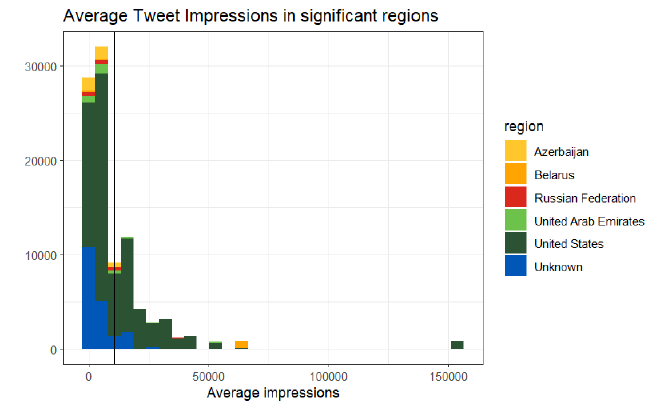
Account types are categorized as follows:
- NewsFeed: accounts acting as news outlets
- LeftTroll: accounts that shared left propaganda
- RightTroll: accounts that shared right propaganda
- HashtagGamer: accounts that mainly tweeted hashtags
- Fearmonger: account spreading fake news about scandals
- Commercial: accounts that acted as businesses
The times at which the tweets were posted also act as indicators of the event they were targeting, pattern that can be exposed via time series plot.
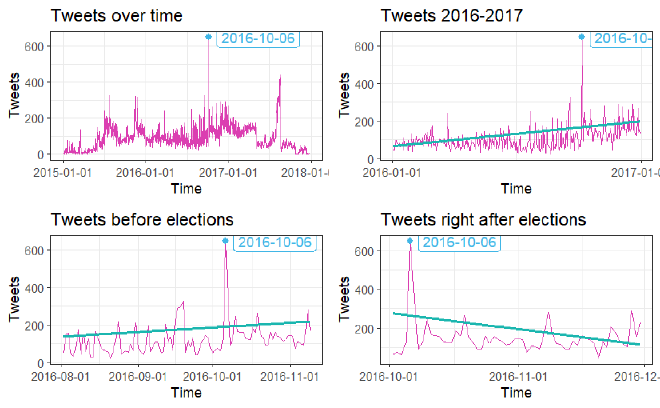
As can be observed, tweets steadily increased until a few days after the election, when they started dropping.
4.2.2.Methods #
The following analysis was done within the R programming language.
4.2.2.1.Text Mining #
Text Mining: Text Mining is defined in this paper as a set of techniques used for deriving information from patterns in a text.
In this part of the analysis we focused on tokenizing by word.
Tokenization, in the context of language processing, is defined as the separation of a document or body in units called tokens that can be of varying length.
The first analysis we conducted is Tf-Idf.
Tf-Idf, or Term Frequency - Inverse Document Frequency, is a statistic that reorders words by adjusting for the fact that some naturally occur more in a text.
It assigns a low weight to common words (tf) and a high weight to rare ones (idf), and returns the words that have the highest values of tf∗idf. The idea is to find a middle point between the two, as some words may be important to describe a text, while not being the most commonly used.
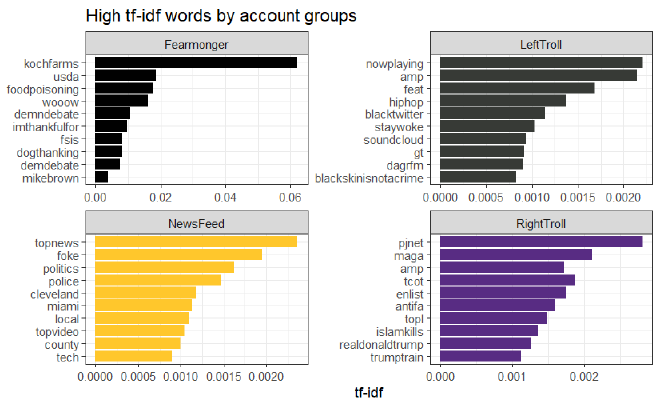
The high tf-idf words, plotted by account category, highlight common topics to the 2016 elections and other high impact words (some of which were hashtags, included for completeness) like “Islam kills”, “black skin is not a crime”, “food poisoning”, and “stay woke”.
4.2.2.2.Sentiment Analysis #
Sentiment Analysis is a delicate tool. While it’s powerful enough to reveal sentiments connected to singular words, there are important ethical considerations to uphold [30], and may portray information in a biased way if not handled with care.
Within the confines of our dataset, and other scholarship on the topic[27], sentiment analysis proves to be a powerful instrument, especially for cases when the text itself is one of the only traces left behind by the astroturf operation.
Sentiment analysis was conducted by joining our tweets, tokenized by word, with three different sentiment lexicons.
A sentiment lexicon is defined in this paper as a collection of words associated with one or more sentiments, which may be positive, negative, neutral, or an emotion.
The lexicons we used in our analysis are the current most utilized ones and each provide different interpretations of “sentiment”:
- the NRC[14] lexicon associates each word with one or more emotions, from the basic eight ones and two sentiments: anger, fear, anticipation, trust, surprise, sadness, joy, disgust plus positive and negative
- the Bing[15] lexicon categorizes words as either positive or negative
- the AFINN[16] lexicon assigns values to words, ranging from −5 to +
Our analysis mainly focused on the NRC lexicon, due to its ability in assigning words to a specific emotion, the other two lexicons were used as baselines and for validation.
That being said, we analyzed single words according to their sentiments.

While this is definitely a crude plot, one will start to notice a pattern in the following analyses regarding the “fear” and “trust” sentiments.

Aside from the emotion association we were also able to check the degree of positive and negative words that are present in the tweets according to the NRC lexicon, which covers for the issue of bimodal polarization not being accounted for [26].
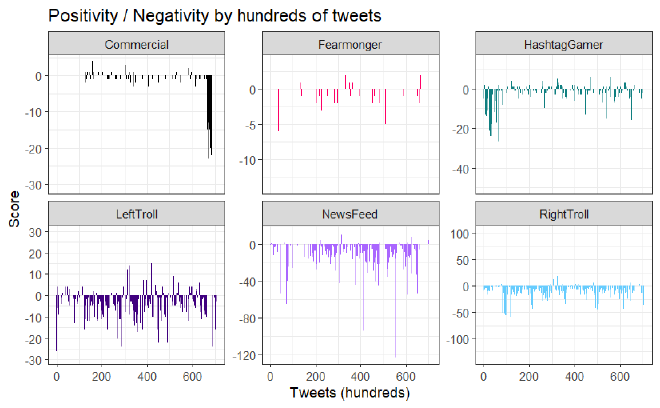
The overall sentiment scores for this lexicon are pretty negative, validation with the use of multiple lexicons, academically considered the optimal choice in sentiment analysis[31], accounting for biases that may come from a specific lexicon [4].
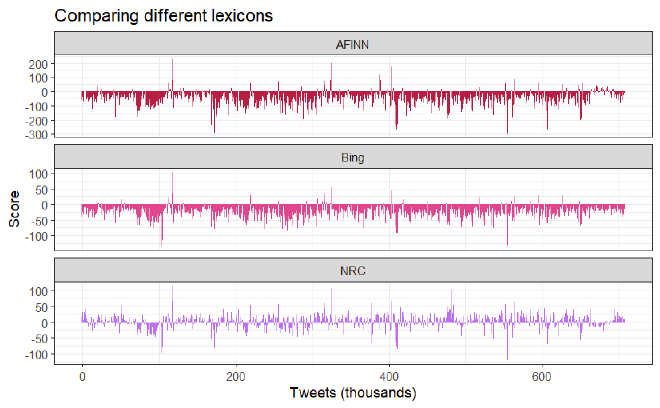
As it turns out, NRC was the most positive lexicon out of the three, containing a higher ratio of positive-to-negative words in respect to the other lexicons. To explain the discrepancies, we looked at the single word count by sentiment.
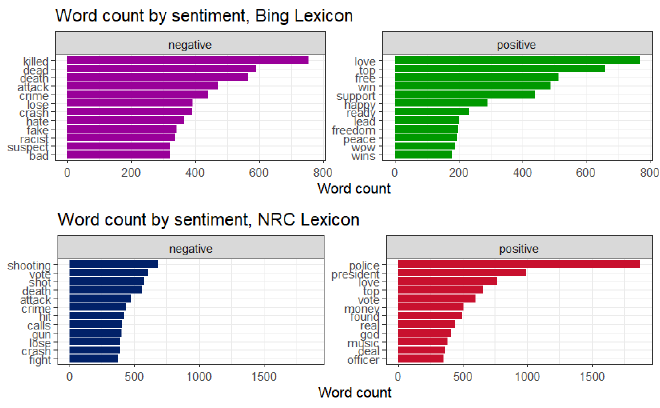
The difference now is understandable, given the fact that the NRC lexicon assigned a positive value to words like “police” and “officer”, some of the most used words in our dataset, and usually in contexts of shootings, accidents, revolts and general negative events.
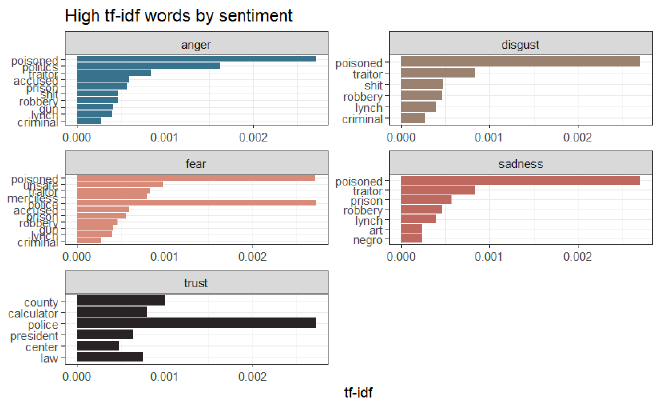
Finally, to supplement our previous findings with the current techniques, we analyzed high tf-idf words according to their assigned sentiment.
4.2.2.3.LDA #
LDA, latent Dirichlet allocation[17], is an algorithm that splits sets of words into topics. This happens automatically, with us having to supply the algorithm an amount N of unnamed topics. LDA works by dividing the documents’ (tweets) corpuses (the tweets’ texts) into topics, each document is treated as a mixture of topics, and topics as word mixtures, which allows for the identification of “overlapping” in terms of content,found as to maximize the model’s ability to predict where words come from and which documents they come from [17].
For example, the word pierogi may have a 5% chance of being found in any one document from the topic 4; we might then observe that the word pizza also has a 4% change of coming from the topic 4. As the model develops its clusters, even though they’re unnamed, it becomes simple to observe the topics as concentrations of words that are similar in meaning (e.g. pizza, pierogi, pasta, spätzle,…). We can then use these newly formed and labelable topic to conduct a sentiment analysis that is conditional on the topic itself (for example we may find that the topic “food” is dominated by positive sentiments, like “happy” from people eating the food, or by negative ones, like “fear” from inflation).
Our aim in using LDA is identifying patterns in the tweet that may cause polarization in the readers. Acknowledging the mentioned potential issues on algorithm and data use and interpretation in Simons [20] and Diaz-Bone [19], we argue that, in this specific case, machine learning can prove to be a powerful tool for interpretation. As argued by Diaz-Bone et al. [19] “ big data should not merely be conceived of as numerical representation of individual behavior, but instead social reality itself needs to be seen as being transformed into digital processes ”, which can be directly applied to our dataset, returning an interpretation of the online social reality of the period, allowing us to evince patterns with the aid machine learning.
As mentioned, before commencing LDA modelling, an optimal number of N topics must be selected. We managed to do just that with the aid of the ldatuning R Library[32], which compares the state of the art statistical measures for selecting the correct number of topics: Griffiths [33], Cao Juan [34] and Arun [35]. We selected 25 as the number of topics in our analysis.
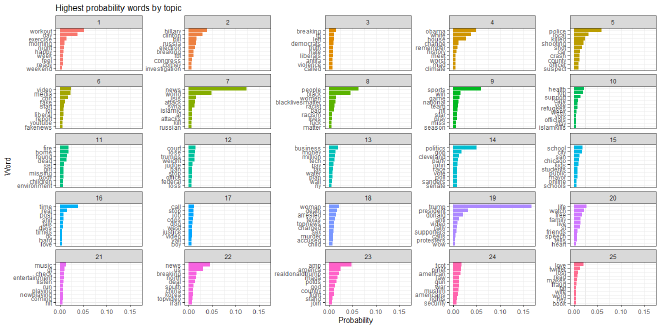
25 topics found by the LDA
From the word probabilities being isolated, we were able to conclude that the model was able to isolate the topics quite proficiently, and characterize the most probable words coming from the topics.
We observed several clear topic being distinguished, some of which along political lines, like the Obama presidency, Hillary Clinton and Donald Trump. Some of which along cultural topics, like workouts or sports.
For example, let’s take a look at the most probable words for topic 7:
| Word | Topic 7 | Topic 8 | Topic 9 | Topic 10 |
|---|---|---|---|---|
| russian | 0.0061 | NA | NA | NA |
| kill | 0.0062 | NA | NA | NA |
| attacks | 0.0071 | NA | NA | NA |
| al | 0.0072 | NA | NA | NA |
| islamic | 0.0075 | NA | NA | NA |
| syria | 0.0122 | NA | NA | NA |
| attack | 0.0132 | NA | NA | NA |
| isis | 0.0152 | NA | NA | NA |
| world | 0.0486 | NA | NA | NA |
| news | 0.1237 | NA | NA | NA |
In this case the algorithm isolated words relating to world news about conflicts, and it managed to do so quite well, since these words only appear in Topic 7 (with the exception for “news”, which also appears in topic 22, a topic about political world news). This tells us that the topic probably captured News Feed accounts talking about attacks, killings, and events of similar impact.
The values under the “Topic N” columns are the probabilities that each word has of generating from a given topic, which obviously, due to the limiting format of a tweet and wide choice of words, turned out to be quite low.
Now, for the final step in our analysis, we analyzed the topics isolated by the algorithm with the sentiment analysis lexicon, looking for potential patterns of polarization in the language.
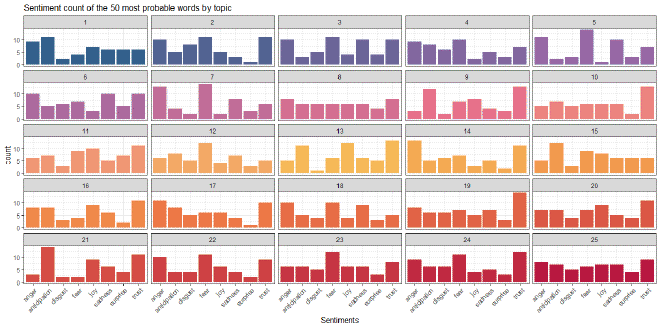
Topics found by the LDA with respective sentiment count
While it’s easily noticed that there are various similarities between the distributions of sentiments in many of the topics, containing high values of “fear” and “trust”, another key layer is introduced when one factors in the collection of words that are associated with each topic.
For example, we observed that topic Trump (19) is correlated with high feelings of trust, hope. This is far and away the strongest visible pattern of this analysis, showing clearly the intent behind the operation: through subtle and hard-to-detect political messaging, to associate Trump with hope for the future and positivity, and his opposition with negativity.
4.2.3.Considerations #
Our analysis has attempted to show the hidden dynamics of the 2016 astroturfing, while not generalizable to all astroturfing operations and CIBs, the patterns revealed are quite clear. The IRA’s agenda was to use polarization-inducing rhetoric throughout many different areas, identified by LDA, in order to manipulate public opinion and advance right-wing messages.
The choice of words in this political discourse serves the main objective of information contagion: american citizens upon accessing twitter would be faced with the messages, shown to garner more traction [25], and perceive the ideas as widely shared, thanks to the crowd conformity principle.
The traces of right-wing populist messages in the tweets can be identified in key topics highlighted by LDA,for example: the (at the time) current state of America was heavily criticized by Fearmonger and NewsFeed accounts by sharing scandals (topics 5,6), accidents and out-group antagonizing events, often related to key minorities like Muslims, Russians (topic 7), afro-Americans (topic 8) or foreigners, further highlighted by the overall negativity of the tweets, the highest sentiment tf-idf words being along the lines of “traitor”, “lynch” and “poisoned” and the sentiment carried by words being mostly of fear and anger (figure 2).
In the meantime a smear campaign was being held against left-wing politicians and ideologies (topics 2,3,4), associating them to “woke” (topics 8,21) ideas, and portraying the topics with words carrying high values of fear and anger, as shown by the sentiment analysis (figure 2).
But the key part of the whole operation was located in the actual support for the right-wing ideologies which, embodying the soul of astroturfing, shows artificial grassroots support. Since his first term Trump has engaged in authoritarian populistic practices [36], “solving” political and economical problems with nationalistic answers, and, even if the investigation on the elections failed to tie him to the IRA [1], the IRA’s modus operandi played right into his field.
The demagogy underlying Trump’s election in the astroturfing was multi-faced and structured as follows: In the context of a “decaying” America with “woke” leaders the IRA promoted a cult of the personality, surrounding Trump-related topics (topics 19, 23) with trust’connected words (figure 2), while doing the same for topics concerning his political agenda and key messages. The astroturfing appealed to the masses by spreading messages of wealth and stability (topic 13), nationalism and religion (topics 9, 12, 23, 24), while discrediting information as part of a “fake news” campaign (topic 6), tactic shown to be highly correlated to populists [36], essentially portraying Donald Trump’s image to evoke trust and nationalism. Once again, this is corroborated by the account category tf-idf statistic, which identified words like “maga”, “PJnet” (a rightwing news outlet) and “tcot” (an hashtag meaning “top conservative on twitter”) as the most significant for RightTrolls. The mentioned topics are also shown to have been portrayed with words associated with anticipation and trust (figure 2).
Our findings thus corroborate the current scholarship on the topic [9], as it’s been shown that misinformation is used as a tool for populist agendas, also by Trump himself, using a multitude of manipulation tactics [36]. The interpretation is also consistent with literature on the more general topic of online polarization, with the troll’s usage of polarizing language with the intent of sowing polarization in a target population [25]. While the types of analyses conducted were different, our conclusions are also consistent with the ones of original researchers and creators of the dataset we used Darren Linvill and Patrick Warren, in the support and consolidation of a shared identity by the Trolls.
5.Conclusion #
It’s our conclusion then that the IRA’s campaign of polarization is a clear example of how an Astroturf campaign can, when successful, have a profound impact on the targeted population, manipulating their public opinion and radicalizing their beliefs with fake grassroots words of trust for the supported idea. We easily observed the recognition of its effectiveness in the literature we cited, and the results of our data analysis corroborates what we already know to be their intention.
5.1.Findings #
In this paper we observed that during the 2016 election season, there’s clear patterns that we can observe through sentiment analysis that characterize this specific astroturf operation orchestrated by the IRA. Through text analysis, we could observe specific sets of words, through sentiment analysis we could observe the choice in sentiments to be boosted, and through LDA analysis we could observe the distribution of both of these across specific topics. The findings of such tactics were supplemented by the use of more common text-mining approaches like word frequencies and tf-idf.
It’s become apparent that the whole operation was a large-scale manipulation attempt, achieved with the use of polarizing rhetoric hidden inside authoritarian-populistic tweets. Astroturf operations have been shown to have exacerbating effects on political polarization [8]. For example, it’s been corroborated in our specific case that the IRA’s campaign was not one of propaganda as much as it was one of political polarization[37]. This is because, as we alluded to earlier, it’s easier to bend the populace’s perception of facts when they live in “Parallel Worlds”. The explanation for this is that the key mechanism the IRA is exploiting, is that exposure to opposing views can in fact build polarization[38].
For example, we noticed that Trump-adjacent topics were commonly associated with positive sentiment, like “trust”, and by far right-leaning words and ideas were by far the most shared on our dataset. From the combination of these analyses, scholarship review, and our interpretative work, we corroborate the assumption that IRA’s intention was to aid President-Elect Donald in winning the presidency in 2016. This tracks with the findings of the Mueller report [1] and of most other literature on the subject.
The sentiment analysis conducted acted as a “polarization thermometer” over the LDA-identified target areas, revealing what the words in each message are supposed to induce, mainly returning fear (and anger) for the future and the opposition, against trust (and anticipation) for right-wing ideas and candidates.
Fear and Trust are the bread and butter of this astroturfing. The fear of consequences in the case political opponents win, coupled with artificial trust in one’s candidate again, prove to be exactly the reasons why such behaviors can be so polarizing. By exposing the american twitter users to select pandering populist messages, the IRA manipulated public opinion.
5.2.Social Relevance of the research #
We believe that there’s significant social relevance to these results. While we touched on other topics as well, we find it particularly poignant to observe the effect they can have on the rule of law, and more broadly of its perception.
5.2.1.Effect on Rule of Law #
The primary purpose of campaigns of the 2016′s IRA is that of exacerbating political polarization. This means breeding distrust both in the opposition and in the ability of standard, current time institutions to correctly handle such (perceived) existential differences between the two sides.
This lack of trust for what are fundamental institutions in the rule of law, such as the court system or the legislative branch, as has been visible with Mr. Trump’s recent involvement and undermining of both of these, has the potential to root out the public support of the rule of law system, pushing towards a rule of man system [39].
This happens mainly through the creation of a a faux association of rule of law (aka, the system ) and corruption, pointing the new ruling man as the only realistic hope of draining the swamp. This showed up in our data through Trump (their chosen man ) being associated with very high levels of trust.
5.2.2.Effect on Civil Society and Political Culture #
Civil Society is a crucial component of the functioning of society. It’s the breeding ground for the distribution and usage of social power, which itself shapes political culture, and by extension policy.
By polarizing the victims, astroturf campaigns contribute in exacerbating the problems of parliamentary systems and democracies in general: by creating a divided populace that can’t find nay middle ground, the system grinds to a halt as compromise is harder and harder to reach.
In this sense, Astroturf poses a threat to the critical function a “civil” civil society [23] needs to perform in order to maintain democratic institutions.
References #
[1] M. Robert, “Report On The Investigation Into Russian Interference In The 2016 Presidential Election,” Apr. 2019. [Online]. Available: https://www.justice.gov/storage/report.pdf
[2] U. Department of Justice, Two RT Employ, ees Indicted for Covertly Funding and Directing U.S. Company that Published Thousands of Videos in Furtherance of Russian Interests. 2024. [Online]. Available: https://www.justice.gov/opa/pr/two-rt-employees-indicted-covertly-funding-and-directing-us-company-published-thousands
[3] J. Jacob, N. Suresh, K. Ethan, and W. S. Laurence, “Political Polarization and the Dynamics of Political Language Evidence from 130 Years of Partisan Speech,” 2012. [Online]. Available: https://www.columbia.edu/~lhw2110/2012b_Jensen.pdf
[4] S. Cris and W. Susan, “Audit Culture Revisited: Rankings, Ratings, and the Reassembling of Society,” Jun. 2015. [Online]. Available: https://www.journals.uchicago.edu/doi/full/10.1086/
[5] Delia Baldassarri and Peter Bearman, “Dynamics of Political Polarization,” Oct. 2007. [Online]. Available: https://doi.org/10.1177/000312240707200507
[6] W. Edward, “Astroturf Lobbying,” Jan. 01, 2022. [Online]. Available: https://doi.org/10.1007/978-3-030-44556-0
[7] I. Lock and P. Seele, “The Consequences of Astroturf Lobbying for Trust and Authenticity,” Apr. 01, 2017. doi: https://doi.org/10.22522/cmr 20170121.
[8] Franziska B. Keller, David Schoch, Sebastian Stier, and JungHwan Yang, “How to Manipulate Social Media Analyzing Political Astroturfing Using Ground Truth Data from South Korea,” May 2017. [Online]. Available: https://www.researchgate.net/publication/317290047_How_to_Manipulate_Social_Media_Analyzing_Political_Astroturfing_Using_Ground_Truth_Data_from_South_Korea
[9] Michael T. Oswald, “Shaping Public Opinion Digitally, Astroturfing and Elections,” Aug. 2018. [Online]. Available: https://www.researchgate.net/publication/327449837_Shaping_Public_Opinion_Digitally_Astroturfing_and_Elections
[10] k. Gary, P. Jennifer, and R. Margaret E, “How the Chinese Government Fabricates Social Media Posts for Strategic Distraction, Not Engaged Argument,” Jul. 27, 2017. doi: https://doi.org/10.1017/S0003055417000144.
[11] C. Jovy, “Online astroturfing, A problem beyond disinformation,” Jun. 16, 2022. doi: https://doi.org/10.1177/01914537221108467.
[12] Dhrumil Mehta, Gus Wezerek, and Andrei Scheinkman, [Online]. Available: https://github.com/fivethirtyeight/russian-troll-tweets
[13] Edward L. Bernays, “Manipulating Public Opinion, The Why and The How,” May 1928. [Online]. Available: https://www.journals.uchicago. edu/doi/10.1086/
[14] “NRC lexicon.” [Online]. Available: https://doi.org/10.4224/
[15] “Bing lexicon,” Dec. 19, 2024. [Online]. Available: https://dl.acm.org/doi/10.1145/1014052.1014073
[16] “AFINN lexicon.” [Online]. Available: https://arxiv.org/abs/1103.
[17] David M. Blei, Andrew Y. Ng, and Micheal I. Jordan, “Latent dirichlet allocation,” Dec. 19, 2024. [Online]. Available: https://dl.acm.org/doi/10.5555/944919.
[18] G. Jhonathan, “Data witnessing: attending to injustice with data in Amnesty International’s Decoders project,” Feb. 20, 2019. doi: https://doi.org/10.1080/1369118X.2019.1573915.
[19] R. Diaz’Bone, K. Horvath, and V. Cappel, “Social Research in Times of Big Data: The Challenges of New Data Worlds and the Need for a Sociology of Social Research,” 2020. doi: https://doi.org/10.12759/hsr.45.2020.3.314'341.
[20] S. Josh, Algorithms for the people: Democracy in the Age of AI. 2023. [Online]. Available: https://www. jstor.org/stable/j.ctv2vjrj0m
[21] S. David, Franziska B. Keller, S. Sebastian, and Y. JungHwan, “Coordination patterns reveal online political astroturfing across the world,” Apr. 17, 2022. [Online]. Available: https://www.nature. com/articles/s41598-022-08404'9#Sec
[22] Permanent Select Committe on Intelligence, “Exposing Russia’s Effort to Sow Discord Online, The Internet Research Agency and Advertisements,” Feb. 16, 2018. [Online]. Available: https://democrats-intelligence.house.gov/social-mediacontent/
[23] Edward Walker and Andrew Le, “Poisoning the Well: How Astroturfing Harms Trust in Advocacy Organizations,” Oct. 22, 2022. [Online]. Available: https://doi.org/10.1177/
[24] Tong Chen and Jiqiang Liu, “Survey on Astroturfing Detection and Analysis from an Information Technology Perspective,” Dec. 01, 2021. [Online]. Available: https://doi.org/10.1155/2021/3294610
[25] Almog Simchon, William J Brady, and Jay J Van Bavel, “Troll and divide: the language of online polarization,” Mar. 2022. [Online]. Available: https://doi.org/10.1093/pnasnexus/pgac
[26] Veronika Patkós, “Measuring partisan polarization with partisan differences in satisfaction with the government: the introduction of a new comparative approach,” Feb. 27, 2022. [Online]. Available: https://doi.org/10.1007/s11135-022-013508
[27] Mohammad Nur Habibi and Sunjana, “Analysis of Indonesia Politics Polarization before2019 President Election Using Sentiment Analysis and Social Network Analysis,” Nov. 08, 2019. [Online]. Available: https://www.mecs’press.org/ijmecs/ijmecs’v11’n11/IJMECS’V11’N11'4.pdf
[28] P. Gabriele, P. Massimo, P. Massimiliano, and G. Vincenzo, “A Comparison of Different Topic Modeling Methods through a Real Case Study of Italian Customer Care,” 2023. doi: https://doi.org/10.3390/a16020094.
[29] Darren L Linvill, Patrick L Warren, and Amanda E Moore, “Talking to Trolls—How Users Respond to a Coordinated Information Operation and Why They’re So Supportive,” Nov. 28, 2021. [Online]. Available: https://doi.org/10.1093/jcmc/zmab
[30] M. Saif. M, “Practical and Ethical Considerations in the Effective use of Emotion and Sentiment Lexicons,” Nov. 2020. doi: http://dx.doi.org/10.48550/arXiv.2011.03492.
[31] C. Gabriela and S. David, “Two is better than one: Using a single emotion lexicon can lead to unreliable conclusions,” Oct. 14, 2022. doi: https://doi.org/10.1371/journal.pone.0275910.
[32] Nikita Murzintcev, “Select number of topics for LDA model.” [Online]. Available: https://cran.r-project.org/web/packages/ ldatuning/vignettes/topics.html
[33] Thomas L. Griffiths and Mark Steyvers, “Finding scientific topics,” 2004. doi: http://doi.org/10..
[34] Cao Juan, Xia Tian, Li Jintao, Zhang Yongdong, and Tang Sheng, “A density’based method for adaptive lda model selection. Neurocomputing,” 2009. doi: http://doi.org/10.1016/j.neucom.2008..
[35] Rajkumar Arun, V. Suresh, C. E. Veni Madhavan, and M. M. N. Narasimha, “On finding the natural number of topics with latent dirichlet allocation,” 2010. doi: http://doi.org/10.1007/978'3’.
[36] M. Hameleers, “Populist Disinformation: Exploring Intersections between Online Populism and Disinformation in the US and the Netherlands,” Mar. 05, 2022. [Online]. Available: https://doi.org/10.17645/pag.v8i1.
[37] David Schoch, Franziska B. Keller, Sebastian Stier, and JungHwan Yang, “Coordination patterns reveal online political astroturfing across the world,” Apr. 17, 2022. doi: https://doi.org/10.1038/s41598-022-08404-9.
[38] Christopher A. Bail, Lisa P. Argyle, Taylor W. Brown, Alexander Volfovsky, and et al., “Exposure to opposing views on social media can increase political polarization,” Oct. 18, 2018. doi: https://doi.org/10.1073/pnas.1804840115.
[39] T. Ginsburg, M. Versteeg, J. Meierhenrich, and M. Loughlin, Rule of law measurement. 2021. [Online]. Available: https://doi.org/10.1017/9781108600569
Reply by EmailNote: in copying references from typst to markdown, some links broke. If you find a broken link, feel free to contact me at one of the contacts. I can provide links for the sources. Alternatively, here’s the pdf

